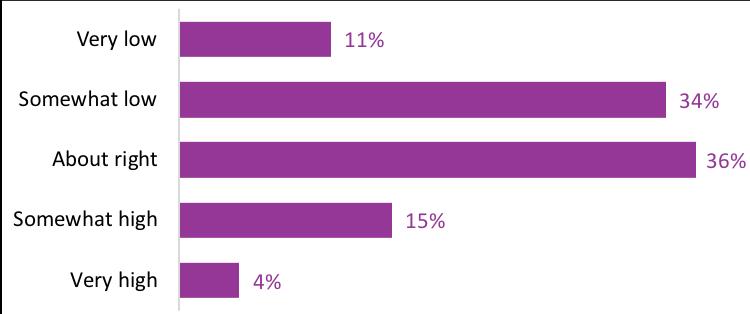
2 minute read
Returns
Returns
Last but not least in our look at bookstore operations is return. The average return rate for the bookstores who completed our survey was 17%, with half of respondents having a return rate of 15% or higher (the median was 16%). When we segment this by size of bookstore, we find that the average return rate is lower for small bookstores (revenue under $450K) (14%) and higher for medium (16%) and large bookstores (22%).
The majority of booksellers thought their rate of returns to suppliers was about right (36%) or somewhat low (34%).
Perception of the return rate
n=47
Even though most booksellers thought the rate of returns were about right or somewhat low we still solicited suggestions for reducing or better managing the level of returns. Ideas were put into three categories: COVID-19 related, internal, and industry. But, as one bookseller noted, “there is no easy solution or it would have happened.”
In the COVID-19 category, booksellers commented that because of COVID-19 they weren’t able to sell to customers, that online events weren’t bringing in the same volume of sales as in person events, and/or that they didn’t know that their suppliers/distributors were able to receive returns (this was related to supply chain constraints due to COVID-19).
Here are some ideas from booksellers to implement within their store(s) and incorporate into internal processes to remove the financial burden of hanging onto overstock:
● allocate more staff time to returns ● work on increasing stores’ customer base ● buy with the intent to sell ● buy fewer copies of frontlist titles ● reorder more frequently ● make time to evaluate stock monthly ● pay attention to special orders as indication of overlooked titles
More systemic ideas that booksellers suggested to reduce or better manage the level of returns are industry-wide:
● discount shipping prices/reduced freight costs (Canada Post, etc.) ● faster shipping to get replacements quicker and order fewer copies more often ● remove return restrictions to return slower moving stock ● allow bookstores to discount books for sale instead of returning
“[A way to reduce returns is to have] regional warehouses that have adequate stock. If we could re-stock more quickly, we would be able to better respond to a book selling more quickly than anticipated. The majority of what we return are leftover copies of books that we want to have sufficient inventory of for its initial release, or copies of a book that we received too late and was purchased at a different vendor. A broader network of warehouse locations would make it easier for us to be nimble.”
“Getting the Globe and Mail to review books in a timely way would also help. Having to scramble every Saturday morning to discover that three of the five books featured are 9-15 months old, and already returned, and one has not been









